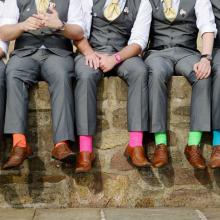gender based violence
"On one side, it's a bold declarative statement that 'I'm not ashamed' and 'I'm not alone.' On the other side, it's a statement from survivor to survivor that says 'I see you, I hear you, I understand you and I'm here for you or I get it," says Tarana Burke.
The United States holds the title for having the highest incarceration rate in the world with 2.3 million incarcerated people. And the most rapidly increasing population imprisoned are women and girls.

Image via Anchiy/Shutterstock.com
Rape. Domestic Violence. Acid Burnings. Female Infanticide. Human Trafficking. Emotional Abuse. Sexual Harassment. Genital Mutilation. These are just a few forms of sexual and gender-based violence (SGBV) that women and girls endure on a daily basis. But these assaults on the human spirit and sacred worth of women and girls will not have the last word.

Image via hxdbzxy/Shutterstock.com
Rape. Domestic Violence. Acid Burnings. Female Infanticide. Human Trafficking. Emotional Abuse. Sexual Harassment. Genital Mutilation. These are just a few forms of sexual and gender-based violence (SGBV) that women and girls endure on a daily basis. But these assaults on the human spirit and sacred worth of women and girls will not have the last word.

Image via Perry Correll/Shutterstock.com
Rape. Domestic Violence. Acid Burnings. Female Infanticide. Human Trafficking. Emotional Abuse. Sexual Harassment. Genital Mutilation. These are just a few forms of sexual and gender-based violence (SGBV) that women and girls endure on a daily basis. But these assaults on the human spirit and sacred worth of women and girls will not have the last word.

Image via MNStudio/Shutterstock.com
Rape. Domestic Violence. Acid Burnings. Female Infanticide. Human Trafficking. Emotional Abuse. Sexual Harassment. Genital Mutilation. These are just a few forms of sexual and gender-based violence (SGBV) that women and girls endure on a daily basis. But these assaults on the human spirit and sacred worth of women and girls will not have the last word.
Bio: Jimmie Briggs is an award-winning journalist and author of Innocents Lost, a book giving voice to child soldiers. In 2009, he co-founded the Man Up Campaign, a global effort to engage youth to stop violence against women and girls, and currently serves as executive director of the U.S. branch of Leave Out Violence (LOVE).
1. Let’s talk about LOVE. What issues does your organization address? LOVE’s focus is to engage young people who have been affected by violence of all kinds. This includes not only gender-based violence, but also issues such as gun violence, witnesses of domestic violence, and trauma- processing in schools where violence is the reality. LOVE uses media arts coupled with a trauma-informed response. We have a social worker for one-on-one counseling, and our teaching artists use media arts to provide pathways for young people who have been affected by violence—survivors and witnesses, even perpetrators—to express their voice and ultimately to process their pain, their trauma, and sometimes their guilt from the violence.
At the same time, LOVE creates a stage for them to speak about their experiences and advocate among their peers about conflict resolution and violence prevention. The arts offer a way to heal and process the violence you’ve experienced, but also for you to reach your peers and mitigate violence from happening in your schools, your home, and in your communities.
SOUTH AFRICA has meant a lot to Sojourners over the years. In the 1980s, I was invited to come to South Africa by key church leaders there, including Beyers Naudé, the first white minister defrocked by the Dutch Reformed Church for opposing apartheid; Desmond Tutu, the Anglican archbishop of Cape Town; theologian and preacher Alan Boesak; and Frank Chikane, a Pentecostal minister who came up through the ranks of the movement to lead the South African Council of Churches.
They became my “comrades,” as they say in South Africa, for six weeks that happened to fall during Lent—it was a powerful season for me of seeing and feeling the pain of that beloved country while looking for the hope that comes from people who make costly commitments. Together we worked on a strategy between South African and U.S. church leaders to end apartheid.
Ten years later I returned to witness the victory of that hope in the miracle of Nelson Mandela’s inauguration as South Africa’s first black president, and later came back for an international reunion of anti-apartheid activists. Those formative years in the South African movement for freedom helped give me my theology of hope—which I learned means believing in spite of the evidence and watching the evidence change.
Some die for choosing, others for not choosing. But they all die because they are women. Rogers was mentally ill, and there is debate about whether it was his illness or a misogynistic culture that caused his rampage. For Farzana’s family, and for the 1000 Pakistani girls and women who die each year in the name of honor, there is no question.
On April 2, the United Nations passed an innovative Arms Trade Treaty aimed at regulating the massive global trade in conventional weapons, for the first time linking arms sales to the human rights records of the buyers. For the first time arms manufacturers and dealers will have to consider the end use of their product — how will their customers use the weapons and to make that information public. The May-June 2013 issue of Maryknoll's NewsNotes explains the potential positive impact the treat could have on women and girls:
A particular element of the Treaty that is cause for much celebration is the inclusion of language that protects women and girls from armed gender-based violence (GBV). In the Preamble of the ATT, it states "that civilians, particularly women and children, account for the vast majority of those adversely affected by armed conflict and armed violence."In the United Nations Declaration on the Elimination of Violence Against Women, violence against women and girls is defined as "any act of gender-based violence that results in, or is likely to result in, physical, sexual or psychological harm or suffering to women [or girls], including threats of such acts, coercion or arbitrary deprivation of liberty, whether occurring in public or in private life."Under Article 7.4 of the Arms Trade Treaty, GBV is included as a binding criterion for considering whether or not to export arms. The exporting party must consider the overriding risk of potential violations of international humanitarian law (IHL), international human rights law (IHRL) and must take into account the risk that the transfer will be "used to commit or facilitate serious acts of gender based violence or serious acts of violence against women and children."
Read the rest here: http://www.maryknollogc.org/article/arms-trade-treaty-global-victory-women-girls




